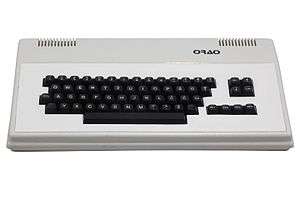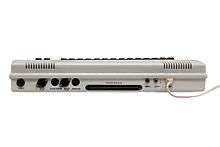Orao (computer)
 Orao | |
| Type | Home computer |
|---|---|
| Generation | 8-bit |
| Release date | Yugoslavia: 1984 |
| Retail availability | 1984–1991 |
| Discontinued | 1991 |
| Media |
Cassette tape Floppy disk[1] |
| Operating system | Orao BASIC |
| CPU | MOS Technology 6502 at 1 MHz |
| Memory | 16 KB / 32 KB |
| Display | RF modulator (video) |
| Sound | internal speaker (audio, early models) or three-channel audio via RF modulator (audio, later models) |
| Predecessor | Galeb (computer) |
Orao (en. Eagle) was an 8-bit computer developed by PEL Varaždin in 1984. Its marketing and distribution was done by Velebit Informatika. It was used as a standard primary school computer in Croatia and Vojvodina from 1985 to 1991.
Orao (code named YU102) was designed by Miroslav Kocijan to supersede Galeb (code named YU101). The goal was to make a better computer, yet with less components, easier to produce and less expensive. The initial version, dubbed Orao MR102, was succeeded by Orao 64 and Orao+.
History
The chief designer of Orao was Miroslav Kocijan, who previously constructed the basic motherboard for Galeb (working name YU101). Galeb was inspired by computers Compukit UK101, Ohio Scientific Superboard and Ohio Scientific Superboard II which appeared in the United Kingdom and the United States in 1979 and were cheaper than the Apple II, Commodore PET and TRS-80. Driven by the challenge of Anthony Madidi, Miroslav Kocijan began to develop a computer that is supposed to be more advanced than the Galeb with fewer components, easier to produce, better graphics, performance and a more affordable price. The working title of the new project was YU102.
Miroslav Kocijan managed to gather around him a group of people who helped in the development of electronic components and software. Kocijan had the idea to commercialize Orao, and was able to convince Rajko Ivanusic, director of PEL, to support the idea. In the market of the former Yugoslavia, where the purchase of home computers were disabled due to high tariffs and due to the low purchasing power of citizens and schools computers were unattainable, the idea of mass-produced home computers made sense.[2]
Serial production and price
The price of Orao was originally set to be around 55.000 Yugoslav dinars, however the price rose to 80.000 dinars. The production began in the summer of 1984. Since the only imported components were integrated circuits which were hard to acquire in Yugoslavia because of strict monetary politics, PEL Varaždin itself financed the imports of these components, which enabled a cheaper final product. Occasional problems that occurred in the serial production were related to the construction of certain external parts and overheating.
Lack of supported software
Considering Orao was not compatible with any computer of the time, software offering was lacking due to the lack of software companies whose products supported the platform.
Architecture
The graphics were controlled by a special circuit, not by the main processor as it was the case in many other home computers because Kocijan's intention was to create a graphical computer similar to Xerox Alto, or Macintosh, and as such, he had it utilize bitmap graphics. The resolution was 256x256 dots, for up to 196,608 bits of VRAM as the graphics could need no more than three bits per pixel. Such a resolution was chosen for square dots, which enabled easy writing of graphical programs. The resolution of text was 32x32, and every character was rendered in an 8x8 field. The designers of Orao went an additional step further to create a computer which could be far more easily expanded, connect with a printer and establish a net connection through RS-232.
Specifications

- CPU: MOS Technology 6502 at 1 MHz
- Read-Only Memory: 16 KB (with BASIC interpreter and Machine code monitor)
- RAM: 16 KB (expandable to 32 KB)
- VRAM up to 24 KB
- Graphics: monochrome 256×256 pixels, in up to 8 shades of gray
- Text mode: 32 lines with 32 characters each
- Sound: single-channel, 5 octaves through built-in loudspeaker
- Computer keyboard: 61-key QWERTZ
- I/O ports: video and RF TV out, cassette tape interface (DIN-5), RS-232 (D-25), Edge expansion connector
- Peripherals: 5.25" floppy drive, Printer
- Price: 55,000 dinars planned but increased to 80,000 during production
Design team
- Miroslav Kocijan
- Branko Zebec
- Ivan Pongračić
- Anđelko Kršić
- Damir Šafarić
- Davorin Krizman
- Zdravko Melnjak
- Vjekoslav Prstec
- Dražen Zlatarek
References
- ↑ Kristian Benić (30 August 2010). "Kompjutori u školama Jugoslavije" (in Croatian). tportal.hr.
- ↑ "Miroslav Kocijan – pionir hrvatskog računarstva" (in Croatian). ZG-magazin. 15 February 2013.
External links
| Wikimedia Commons has media related to Orao (computer). |
- Old-Computers.com page about Orao
- Orao implementation in FPGA
- MESS, Multi-System Emulator which supports Orao
- Orao emulator with source code and some software, as well as Orao 2007 recreation of original computer (page is in Croatian language)
- Orao Emulator written in C#
- Orao Emulator for Android
- ORAO BASKET